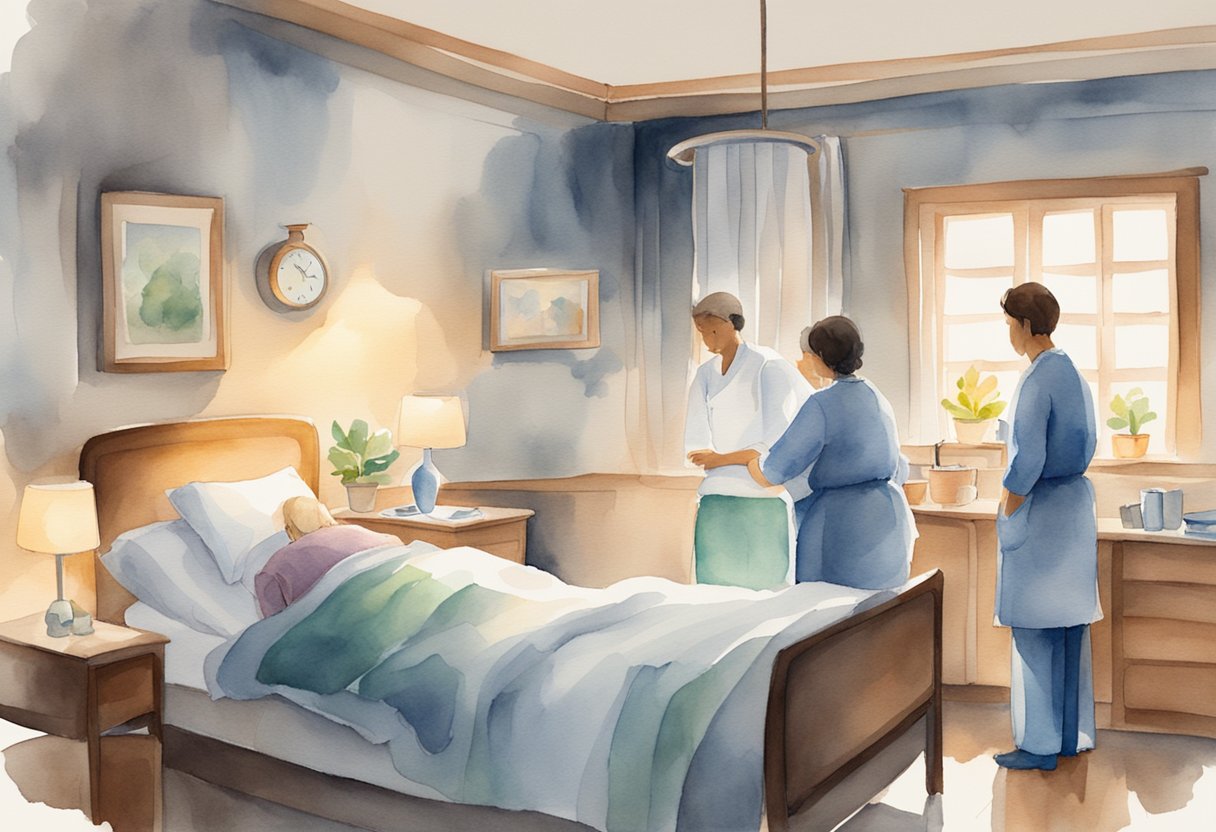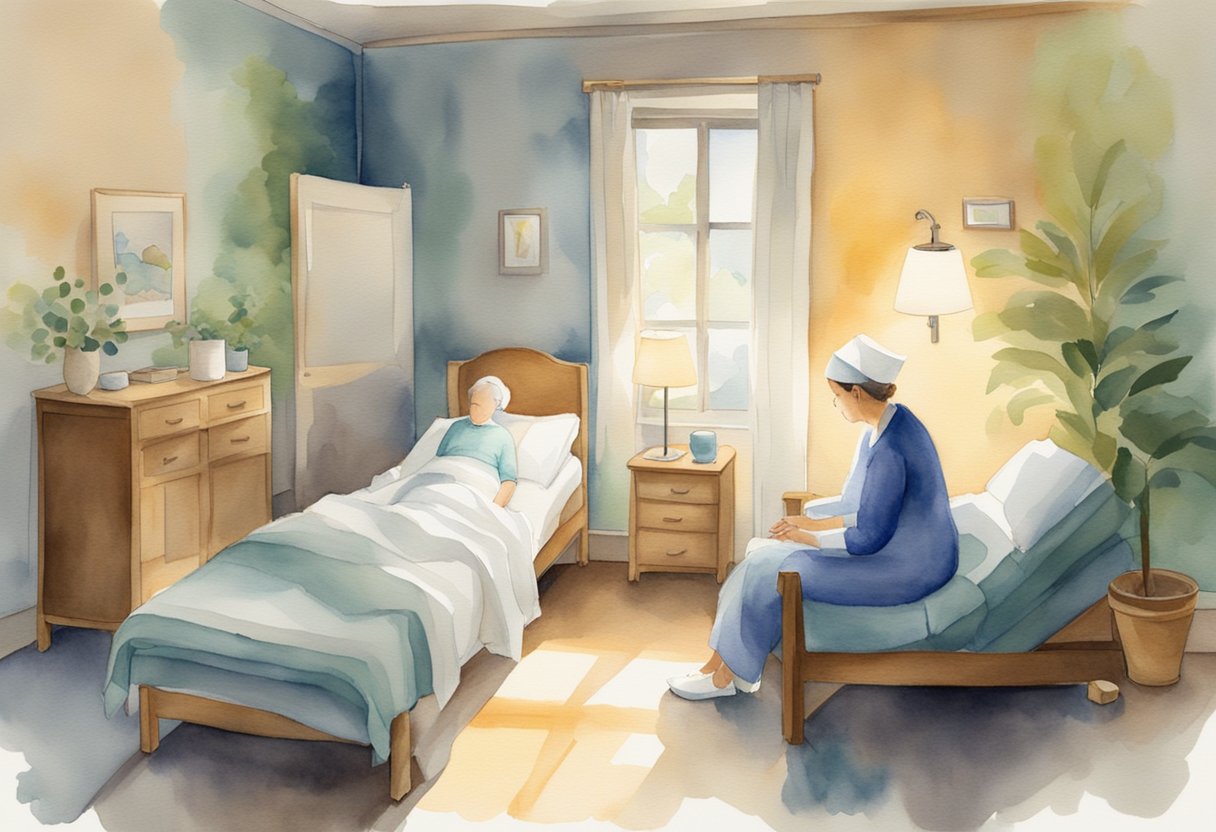Navigating Final Stages with Compassion and Excellence

End-of-life care is an essential consideration for those of us facing the advanced stages of cancer. As we navigate this challenging journey, we focus on maintaining the best possible quality of life and ensuring comfort.
Treatments and medications at this stage are primarily aimed at managing pain and other distressing symptoms like nausea or shortness of breath. This allows us to cherish time with loved ones and focus on personal priorities.
Our experience highlights the complex legal and ethical considerations often accompanying end-of-life care. We recognize the significance of advance directives in granting us the power to make decisions regarding our medical care.
Additionally, discussions around physician-assisted dying highlight our communities’ diverse perspectives and legal nuances. As we reflect on these considerations, communication with our healthcare providers and families takes on a heightened role in planning and ensuring that our care aligns with our values and desires.
Key Takeaways
- End-of-life care prioritizes comfort and quality of life for those with advanced cancer.
- Legal and ethical considerations, including advance directives, are crucial for end-of-life planning.
- Open communication with caregivers and medical professionals supports aligned end-of-life care decisions.
Understanding End-of-Life Care
When facing advanced cancer, we look for care that respects our dignity and eases our journey. This section explores the guiding principles and care options for those in the final stages of life.
Principles of End-of-Life Care
We understand that end-of-life care is about honoring preferences and ensuring comfort. Our healthcare team collaborates to provide comprehensive support, addressing physical, emotional, and spiritual needs.
It’s about providing respectful and humane care to maintain the quality of life throughout this sensitive time.
We recognize the individual’s right to make choices about their care, including decisions on life-sustaining treatments.
Advance directives declare our wishes, ensuring that we retain control over the care we receive, even when we can no longer voice our choices. The idea of physician-assisted dying also enters these discussions, a complex and legally nuanced option that some among us consider.
Types of End-of-Life Care Options
Two primary care options exist for us: palliative care and hospice care.
Palliative care is an approach that improves the quality of life of individuals with serious illnesses, regardless of the diagnosis or the stage of disease. This care can be provided alongside curative treatments.
Hospice care, on the other hand, is reserved for when our cancer can no longer be curbed, typically in the last months of life. It’s a form of care that focuses on palliation of symptoms rather than cure and supports the patient and their loved ones.
We make these choices based on our personal values, disease progression, and the informed guidance of our healthcare team.
Cancer Treatment Near the End of Life

As cancer progresses, we face a critical transition where our focus often shifts from curative treatment to palliative care, ensuring we remain as comfortable as possible.
Evaluating Treatment Options
When we reach the later stages, evaluating treatment options requires careful consideration of the benefits and potential side effects.
At this juncture, chemotherapy might no longer be beneficial and could inadvertently reduce our quality of life. We must weigh these factors with our healthcare team and loved ones.
- Benefits of Treatment: Potential for symptom relief, slight chance of prolonging life.
- Risks of Treatment: Increased discomfort, potential hospital visits, and impact on daily activities.
Managing Cancer Symptoms
Our prime aim in these times is managing cancer symptoms effectively. We understand the distress symptoms can bring, and our goal is to relieve suffering and restore a measure of comfort.
- Common Symptoms: Pain, fatigue, loss of appetite.
- Strategies:
- Medications for pain relief.
- Supportive therapies for emotional well-being.
- Home care assistance.
Legal and Ethical Considerations
As we navigate the complexities of end-of-life care, legal and ethical considerations are paramount. These structures ensure our decisions reflect our wishes and uphold dignity through challenging times.
Advance Directives and Living Wills
Advance directives and living wills serve as the foundation for preemptive healthcare decisions.
Our living will details preferences for medical treatment in scenarios where we cannot voice our choices. It’s vital to outline the interventions we desire clearly and, equally, those we wish to avoid, especially when a cure is not an option and the goal shifts to comfort.
For example, we may specify thresholds for pain management or interventions like mechanical ventilation. By documenting our preferences, we provide a blueprint that guides healthcare providers and loved ones, grounding their actions in our values.
Health Care Power of Attorney
Assigning a health care power of attorney entrusts a designated person with the authority to make health care decisions on our behalf if incapacitation occurs.
Choosing someone who understands and respects our values is crucial. They are responsible for voice decisions that align with our outlined wishes in our advance directive.
This authority applies broadly, from selecting healthcare facilities to making treatment choices.
Regular conversations with our chosen representatives ensure they are prepared to act in our stead, honoring our healthcare and personal values when we cannot.
Psychosocial Aspects of End-of-Life Care
Psychosocial care is a critical dimension of end-of-life support, addressing patients’ and their loved ones’ emotional and spiritual needs during this challenging time.
Coping with Grief and Loss
Grief is a natural response to loss and can profoundly affect those facing the end of life. We find strength in understanding that grief is not a linear process but a journey with many ups and downs.
Our approach includes providing a safe space for expressing sorrow and pain without judgment.
Access to psychosocial challenges in palliative care shows that integrating counseling and support groups fosters a sense of community where individuals can share their experiences and gain solace from others walking a similar path.
We also acknowledge the unique challenges children face when grieving. Tailored support that meets their developmental needs helps them navigate their emotions and mitigates long-term adverse effects.
Although not universally sought, spiritual support can be vital for many, providing solace and a sense of peace in moments of despair. Spiritual care can be a beacon of hope amidst the turmoil for those in distress.
Support for Families and Caregivers
Families and caregivers shoulder a significant amount of stress and often contend with their feelings of depression as they care for their loved ones.
We emphasize coordinated efforts to support these pillars of strength. Our strategies include connecting them with resources for caregivers in palliative care, which not only provide emotional support but also instruct on coping mechanisms for the overwhelming responsibilities they face.
Recognizing the caregiver’s own need for care is paramount. Respite options and caregiver support groups help alleviate the physical and emotional burden.
We also focus on educating families about the balance between caring for their loved ones and self-care to prevent burnout. Open communication, practical assistance, and validation of their efforts form the core support system that we aim to provide.
Addressing Physical Symptoms

When we face advanced cancer, managing physical symptoms becomes a critical element of care. Our focus on pain management, comfort, and adapting to nutrition and appetite changes can create a more bearable journey.
Pain Management and Comfort
Accurate pain control is a right we deserve. Our pain may fluctuate from sharp stabs to a dull, persistent ache.
We explore all avenues—from medications like opioids for severe pain to non-drug therapies like massage and acupuncture.
The teamwork with healthcare providers enables optimized pain control tailored to our individual needs.
- Medications: Opioids, NSAIDs, adjuvants.
- Non-drug therapies include physiotherapy, massage, and warm compresses.
- Comfort measures: Proper bedding, quiet environment, emotional support.
Nutrition and Appetite Changes
Appetite changes are inevitable, and our nutrition intake can often dwindle. We pursue a balanced approach, choosing easy-to-eat foods and supplementing when necessary to combat fatigue and weight loss.
This is not just about eating; it’s about maintaining strength and quality of life.
- Foods: Soft, nutrient-dense foods such as smoothies and soups.
- Supplements: Vitamins and minerals if we fall short on essential nutrients.
- Hydration: Small, frequent sips to stay hydrated. Avoid dehydration, as it can exacerbate symptoms like constipation and shortness of breath.
Other symptoms like fatigue, constipation, and shortness of breath also challenge our journey. We meet these head-on, using our collective knowledge to seek relief.
- For fatigue: Rest periods throughout the day, energy conservation techniques.
- For constipation: High-fiber foods, hydration, and regular physical activity are recommended.
- For shortness of breath: Positioning for easier breathing, paced breathing techniques.
Planning and Communication

In navigating the complexities of cancer care, we recognize the vital roles of open dialogues with health professionals and the judicious orchestration of care settings.
Discussing Prognosis and Care Decisions
As survivors who face lymphoma, we understand how a candid conversation about prognosis shapes our journey. It’s through these heart-to-heart discussions with our doctors that we grasp the probable course of our illness and the treatment decisions that align with our life goals.
We owe ourselves and our families not to avoid these challenging topics. Legal instruments like advance directives serve as our voice when we might no longer articulate our wishes, ensuring that our preferences govern future medical care.
Navigating Hospital and Hospice Arrangements
Deciding to transition to hospice care is a pivotal step that warrants thoughtful coordination. This move often means shifting from active treatment to comfort-focused care, which can be a profound relief for many of us men who’ve endured the rigors of cancer therapy.
Picking the suitable hospice or hospital setting requires clear, frequent talks with an array of health professionals who help us chart a path aligned with our last wishes.
We must be attuned to each other’s needs and preferences and act swiftly and sensibly to tailor our end-of-life experience.
Bereavement and Emotional Support

In our journey through cancer care, we recognize that grief and the need for emotional support are critical aspects to consider. We offer both counseling and connections with community services to support mental health and address feelings like fear and anxiety during this challenging time.
Counseling and Mental Health Care
We find strength in speaking to counselors who are skilled in helping us navigate the complexities of grief and loss. These professionals provide a safe space to express our emotions and guide us through our grief.
They help us face the psychological impacts of losing control over our health and the heaviness of spiritual concerns. Counseling may involve strategies to manage our fears and anxieties, allowing us to find a new balance.
Community and Volunteer Services
We connect with community services that offer various forms of support from volunteers. These individuals, who may donate their time and energy, become pillars we lean on, understanding our emotional needs during and after our cancer journey.
They often aid in practical ways but also provide companionship, which can help us feel less isolated in our fight. Volunteer services often include programs that foster emotional and spiritual support, ensuring we don’t face our worries alone.
Playing Devils Advocate

In our advocacy for quality end-of-life care, we confront complex ethical dilemmas, especially regarding legalities like advance directives or physician-assisted dying.
With these topics, we wade into discussions filled with passion from all sides—each vying for what they believe could uplift patients’ dignity in their final chapters.
Advance directives ensure our healthcare choices remain ours, even if we can’t voice them in critical moments. It’s a powerful tool, granting us autonomy when we’re most vulnerable.
Yet, we must recognize the maze of legislation that can bewilder the best of us, especially those navigating these waters for the first time.
Physician-assisted dying, by contrast, ignites fervent discourse. It tugs at the core of our values—where do we draw the line between personal freedom and ethical boundaries in medicine?
Despite our trials with disease, including lymphoma, and emerging as more compassionate survivors, we know these decisions weigh heavily on each of us, particularly for men who often face societal pressure to remain stoic in their suffering.
Underneath the Advocacy
| Concerns | Arguments |
|---|---|
| Autonomy | Honor personal healthcare decisions |
| Safety | Ensure patient’s welfare |
| Equity | Access for all, not just a few |
| Dignity | Ensure the patient’s welfare |
We stand together, men united by past skirmishes with illness, striving for solutions that honor our final days. Let us continue to volley for change, ever mindful of the contrasting views that shape our collective struggle for peace at the end of life.
Final Thoughts…
As we navigate the challenging trajectory toward life’s end, particularly amid the trials of cancer, considerations extend beyond the clinical. We must also grasp the non-medical threads that weave the fabric of end-of-life care—those of policy and personal choice.
Advance directives serve as a compass, guiding healthcare providers to respect our wishes when we may no longer voice them ourselves.
These legal documents are crucial in our quiet assertion of autonomy, allowing us to outline the care we deem fit for ourselves in our final days.
Physician-assisted dying remains a complex, ethical arena navigated with care and deep personal reflection. Laws vary widely, and where permitted, they offer a choice some of us might consider.
This decision is profound and personal, resonating with the dignity some of us may seek.
Our collective journey with cancer, particularly as men who have faced this adversary, imparts a unique perspective. With each battle survived, we accumulate wisdom—not just about surviving but thriving.
We emerge not weakened but fortified, eager to share our strength with brothers new to this fight.
We confront end-of-life realities not with a sense of capitulation but with the quiet confidence of those who have squared off against mortality and emerged with gratitude for every moment afforded us.
This is the legacy we build as cancer thrivers, one where each step taken—no matter how measured—is a testament to the resilience that defines our spirit.
In this solidarity, we find comfort, a collective embrace that carries us through moments of uncertainty with compassion and a steadfast resolve. -T
Frequently Asked Questions
Navigating the journey of cancer and its care involves clearly understanding the progression of the disease, recognizing the proper stages for specific types of care, and addressing the concerns that arise in palliative situations. We are here to shed light on these pivotal aspects.
What indicators signify a decline in the condition of a patient with cancer?
Our experience shows that a decline may be marked by increased fatigue, less daily activity engagement, and a gradual withdrawal. Weight loss and altered mental status, like confusion, are observable flags hinting at a patient’s condition worsening.
How does the presence of cancer affect the life expectancy of patients receiving palliative care?
Life expectancy can vary widely and depends on factors such as the type of cancer, stage at diagnosis, and overall health.
Our aim in palliative care is to enhance comfort regardless of the prognosis, providing support that aligns with each person’s needs.
What symptoms and signs can be expected in the final weeks of someone living with stage 4 cancer?
In the last weeks, symptoms often intensify; the breath may become labored, and pain management becomes a central focus. We also look out for non-physical signs such as emotional distress or the need for spiritual support.
At what point in the disease progression is it appropriate to consider hospice care for a cancer patient?
We consider hospice care when our medical team agrees that cancer treatments no longer control disease progression and life expectancy is estimated at six months or less.
It’s a time when quality and comfort take precedence in care.
What is the palliative care in the overall treatment plan for cancer patients?
Palliative care is integrated into the treatment plan from diagnosis onward to help manage symptoms and side effects, addressing overall well-being.
It operates on the principle that individuals should have relief from pain and emotional stress throughout their diagnosis and treatment.
What are the key issues to address when providing end-of-life care to oncology patients?
We tackle a spectrum of needs. These include managing pain, offering psychosocial support, and respecting the patient’s wishes regarding treatment choices.
It’s about providing comprehensive care that upholds dignity and peace to the patient and their family.
